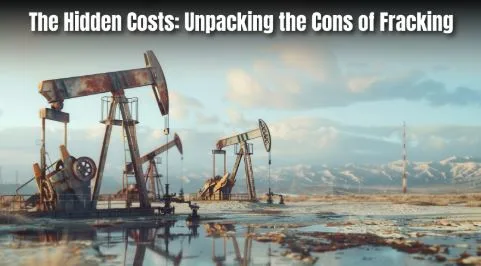The Hidden Costs: Unpacking the Cons of Fracking
Fracking is a way to take oil and gas out of deep underground rock. It began in 1947. In this method, companies drill down and then sideways into the rock. They push water, sand, and chemicals into the ground at high pressure to break the rock and release oil or gas. But what are the pros and cons of hydraulic fracturing?
This method has helped increase oil and gas production, but it also brings many problems. In this blog, we’ll talk about the cons of fracking and why it can be bad for people, nature, and local communities.
Quick Look: The Cons of Fracking
- Dirty water and heavy water use
- Polluted air from chemicals and gas leaks
- Climate change caused by methane
- Land damage and harm to wildlife
- Health risks for nearby people
- Community problems, like road damage and earthquakes
1. Environmental Damage: Nature Suffers
Water Problems
One of the biggest cons of fracking is how it pollutes water. The chemicals used can leak into rivers and underground water. Sometimes, these chemicals are kept secret, so people don’t even know what they’re exposed to.
Each fracking well can use about 1.5 million gallons of water, which is often ruined and can’t be reused. That puts pressure on local water supplies, especially in dry places. Some of the chemicals are toxic, and if they spill, they can damage both drinking water and nearby land.
Air Pollution
Another serious con of fracking is the dirty air it creates. Fracking sites release gases like:
- Benzene
- Toluene
- Methane
- Nitrogen oxides
- Dust and smoke
These gases cause smog, make asthma worse, and can lead to coughing, rashes, and headaches. Fracking also uses heavy trucks and machines that release more pollution. For people living nearby, this can be a big health problem.
Fracking Adds to Climate Change
Fracking releases methane, a gas that traps much more heat than carbon dioxide. Methane leaks during drilling, pumping, and gas storage. Even when it’s burned off (called flaring), the process still adds greenhouse gases to the air.
A big con of fracking is that it makes climate change worse. Studies show that methane leaks are likely much higher than official numbers say. This makes fracking far from clean or green.
Land Damage and Wildlife Loss
Fracking turns quiet natural areas into industrial zones. Companies build roads, pipelines, and large work sites. Since 2005, over 679,000 acres of land have been affected by fracking.
This is another major con of fracking. Forests get cleared. Animals like mule deer and birds lose their homes. Loud noise, bright lights, and air pollution also scare wildlife away. Some spills hurt soil and crops too.
2. Health Problems: How Fracking Hurts People
Health Effects in the Short Term
Many people living near fracking sites complain about:
- Breathing trouble
- Nausea and headaches
- Skin problems
- Dizziness and eye pain
This is one of the key cons of fracking. The chemicals and gas leaks affect people even if they stay indoors. Workers also breathe in harmful dust and gases.
Long-Term Health Risks
Some of the worst cons of fracking come from the long-term health problems. Chemicals like benzene are known to cause cancer.
Other risks include:
- Leukemia in children
- Low birth weight in babies
- Heart disease
- Nerve damage
- Hormone problems
Pregnant women and children are most at risk. Poorer neighborhoods are often hit harder, with less help to deal with the effects.
3. Community and Economic Damage
Home Prices Drop and Roads Break
A serious con of fracking is that it hurts local economies. Homes near fracking sites often lose value, especially if they depend on private wells. Some homes drop in value by up to $30,000.
Fracking brings in heavy trucks that damage roads and increase traffic. Towns often have to pay for repairs, not the oil companies. This can cost taxpayers millions. Local services, like hospitals and schools, also get overwhelmed.
Fracking Can Cause Earthquakes
Another scary con of fracking is the risk of earthquakes. Fracking doesn’t usually cause big quakes directly. But the wastewater from fracking is pushed deep underground, and that can make fault lines slip.
For example:
- Oklahoma now has more earthquakes than before, many linked to fracking.
- One of the biggest quakes caused by fracking was a 5.1 magnitude.
This adds new risks for communities that were once earthquake-free.
Jobs Come and Go Too Fast
Fracking does create jobs, but they don’t last long. At first, towns see a rush of new workers, which raises rent and prices. But when the drilling oil well slows down, many workers leave.
This creates a boom and bust economy. Towns are left with fewer jobs, damaged roads, and less money. That’s one more con of fracking that hurts communities in the long run.
Final Thoughts: Are the Cons of Fracking Too High?
Fracking helps us get more oil and gas, which supports energy needs and jobs. But like any method, it has some challenges. These include using a lot of water, possible air and water pollution, and some effects on land, animals, and nearby towns.
The cons of fracking are real, but many can be managed with better rules, safer equipment, and cleaner ways of working. With the right steps, we can reduce risks while still getting the energy we need.
Fracking brings both benefits and concerns. The goal is to make it safer, cleaner, and better for everyone in the long run.





